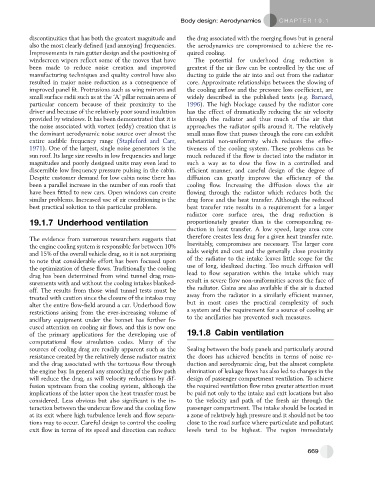Page 659 - Automotive Engineering Powertrain Chassis System and Vehicle Body
P. 659
Body design: Aerodynamics C HAPTER 19.1
discontinuities that has both the greatest magnitude and the drag associated with the merging flows but in general
also the most clearly defined (and annoying) frequencies. the aerodynamics are compromised to achieve the re-
Improvements in rain gutter design and the positioning of quired cooling.
windscreen wipers reflect some of the moves that have The potential for underhood drag reduction is
been made to reduce noise creation and improved greatest if the air flow can be controlled by the use of
manufacturing techniques and quality control have also ducting to guide the air into and out from the radiator
resulted in major noise reduction as a consequence of core. Approximate relationships between the slowing of
improved panel fit. Protrusions such as wing mirrors and the cooling airflow and the pressure loss coefficient, are
small surface radii such as at the ‘A’ pillar remain areas of widely described in the published texts (e.g. Barnard,
particular concern because of their proximity to the 1996). The high blockage caused by the radiator core
driver and because of the relatively poor sound insulation has the effect of dramatically reducing the air velocity
provided by windows. It has been demonstrated that it is through the radiator and thus much of the air that
the noise associated with vortex (eddy) creation that is approaches the radiator spills around it. The relatively
the dominant aerodynamic noise source over almost the small mass flow that passes through the core can exhibit
entire audible frequency range (Stapleford and Carr, substantial non-uniformity which reduces the effec-
1971). One of the largest, single noise generators is the tiveness of the cooling system. These problems can be
sun roof. Its large size results in low frequencies and large much reduced if the flow is ducted into the radiator in
magnitudes and poorly designed units may even lead to such a way as to slow the flow in a controlled and
discernible low frequency pressure pulsing in the cabin. efficient manner, and careful design of the degree of
Despite customer demand for low cabin noise there has diffusion can greatly improve the efficiency of the
been a parallel increase in the number of sun roofs that cooling flow. Increasing the diffusion slows the air
have been fitted to new cars. Open windows can create flowing through the radiator which reduces both the
similar problems. Increased use of air conditioning is the drag force and the heat transfer. Although the reduced
best practical solution to this particular problem. heat transfer rate results in a requirement for a larger
radiator core surface area, the drag reduction is
19.1.7 Underhood ventilation proportionately greater than is the corresponding re-
duction in heat transfer. A low speed, large area core
therefore creates less drag for a given heat transfer rate.
The evidence from numerous researchers suggests that
the engine cooling system is responsible for between 10% Inevitably, compromises are necessary. The larger core
and 15% of the overall vehicle drag, so it is not surprising adds weight and cost and the generally close proximity
to note that considerable effort has been focused upon of the radiator to the intake leaves little scope for the
the optimization of these flows. Traditionally the cooling use of long, idealized ducting. Too much diffusion will
drag has been determined from wind tunnel drag mea- lead to flow separation within the intake which may
surements with and without the cooling intakes blanked- result in severe flow non-uniformities across the face of
off. The results from those wind tunnel tests must be the radiator. Gains are also available if the air is ducted
treated with caution since the closure of the intakes may away from the radiator in a similarly efficient manner,
alter the entire flow-field around a car. Underhood flow but in most cases the practical complexity of such
restrictions arising from the ever-increasing volume of a system and the requirement for a source of cooling air
ancillary equipment under the bonnet has further fo- to the ancillaries has prevented such measures.
cused attention on cooling air flows, and this is now one
of the primary applications for the developing use of 19.1.8 Cabin ventilation
computational flow simulation codes. Many of the
sources of cooling drag are readily apparent such as the Sealing between the body panels and particularly around
resistance created by the relatively dense radiator matrix the doors has achieved benefits in terms of noise re-
and the drag associated with the tortuous flow through duction and aerodynamic drag, but the almost complete
the engine bay. In general any smoothing of the flow path elimination of leakage flows has also led to changes in the
will reduce the drag, as will velocity reductions by dif- design of passenger compartment ventilation. To achieve
fusion upstream from the cooling system, although the the required ventilation flow rates greater attention must
implications of the latter upon the heat transfer must be be paid not only to the intake and exit locations but also
considered. Less obvious but also significant is the in- to the velocity and path of the fresh air through the
teraction between the undercar flow and the cooling flow passenger compartment. The intake should be located in
at its exit where high turbulence levels and flow separa- a zone of relatively high pressure and it should not be too
tions may to occur. Careful design to control the cooling close to the road surface where particulate and pollutant
exit flow in terms of its speed and direction can reduce levels tend to be highest. The region immediately
669

